HRM514 Report: Challenges and Trends in International HRM for MNCs
VerifiedAdded on 2023/06/07
|11
|3757
|172
Report
AI Summary
This report delves into the significant challenges confronting international human resource management (IHRM) within multinational corporations (MNCs). It identifies and analyzes three key trends: technology, education, and mobility. The report explores how technological advancements impact HRM operations, including training, data privacy, and the potential for job displacement. It also examines the challenges posed by varying educational standards and the need for adaptable talent acquisition strategies. Furthermore, the report addresses the impact of global mobility on workforce management, including the effects of changing political landscapes and cultural diversity. It concludes by evaluating the impact of these challenges on future HRM practices, highlighting the need for strategic adjustments in areas such as recruitment, training, and employee relations. Recommendations for addressing these challenges are also provided, emphasizing the importance of proactive and adaptable IHRM strategies in an evolving global business environment.
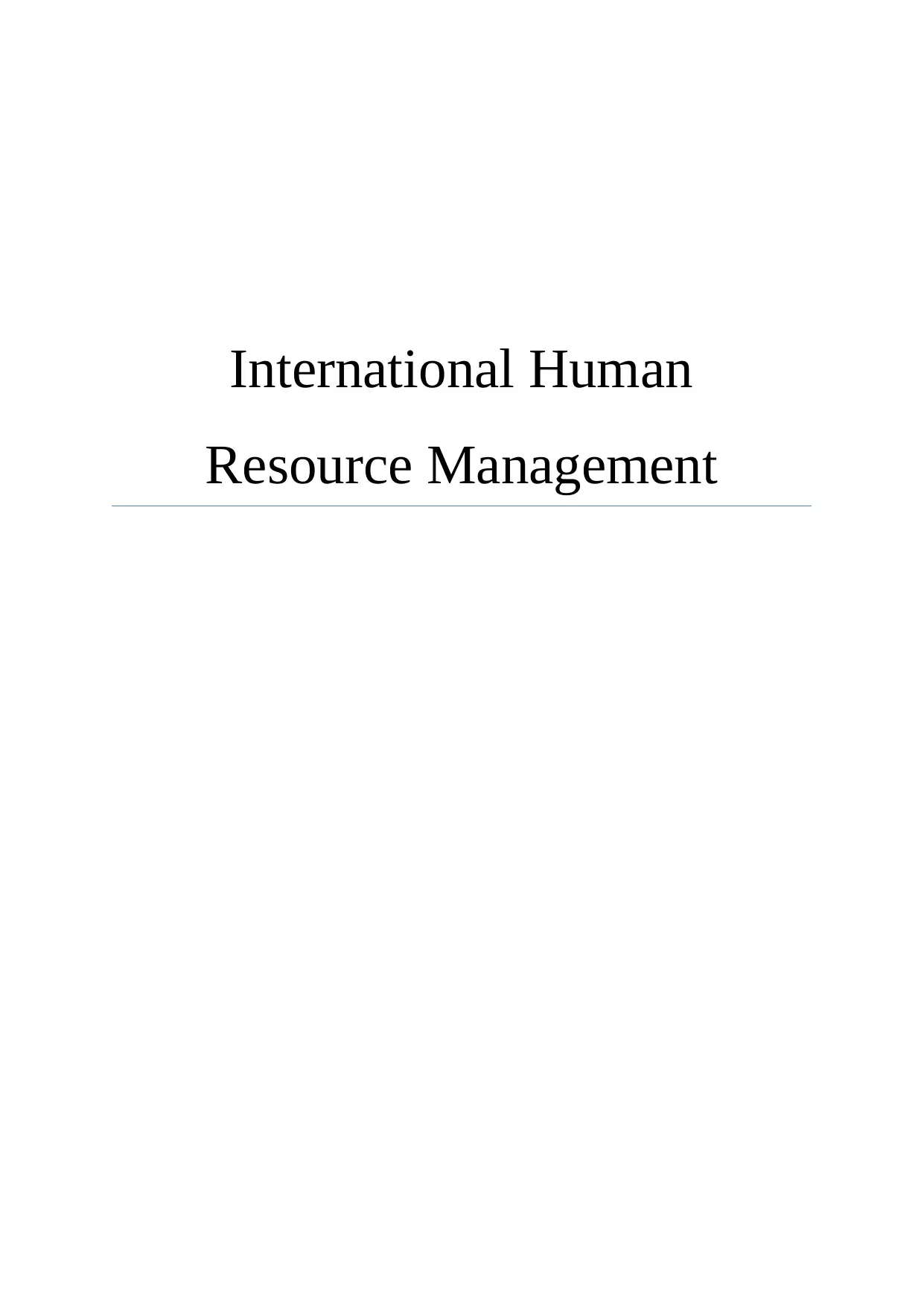
International Human
Resource Management
Resource Management
Paraphrase This Document
Need a fresh take? Get an instant paraphrase of this document with our AI Paraphraser
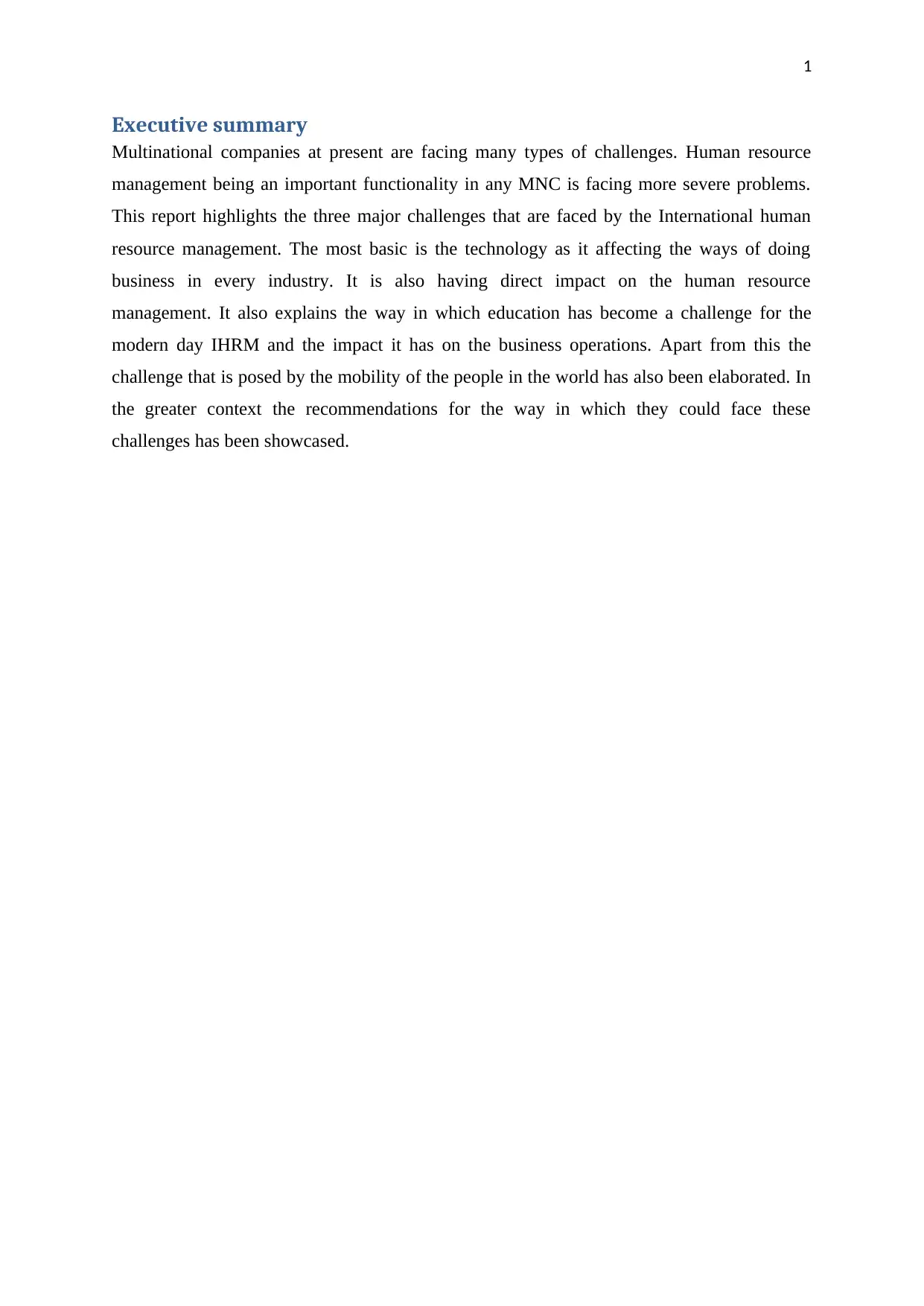
1
Executive summary
Multinational companies at present are facing many types of challenges. Human resource
management being an important functionality in any MNC is facing more severe problems.
This report highlights the three major challenges that are faced by the International human
resource management. The most basic is the technology as it affecting the ways of doing
business in every industry. It is also having direct impact on the human resource
management. It also explains the way in which education has become a challenge for the
modern day IHRM and the impact it has on the business operations. Apart from this the
challenge that is posed by the mobility of the people in the world has also been elaborated. In
the greater context the recommendations for the way in which they could face these
challenges has been showcased.
Executive summary
Multinational companies at present are facing many types of challenges. Human resource
management being an important functionality in any MNC is facing more severe problems.
This report highlights the three major challenges that are faced by the International human
resource management. The most basic is the technology as it affecting the ways of doing
business in every industry. It is also having direct impact on the human resource
management. It also explains the way in which education has become a challenge for the
modern day IHRM and the impact it has on the business operations. Apart from this the
challenge that is posed by the mobility of the people in the world has also been elaborated. In
the greater context the recommendations for the way in which they could face these
challenges has been showcased.
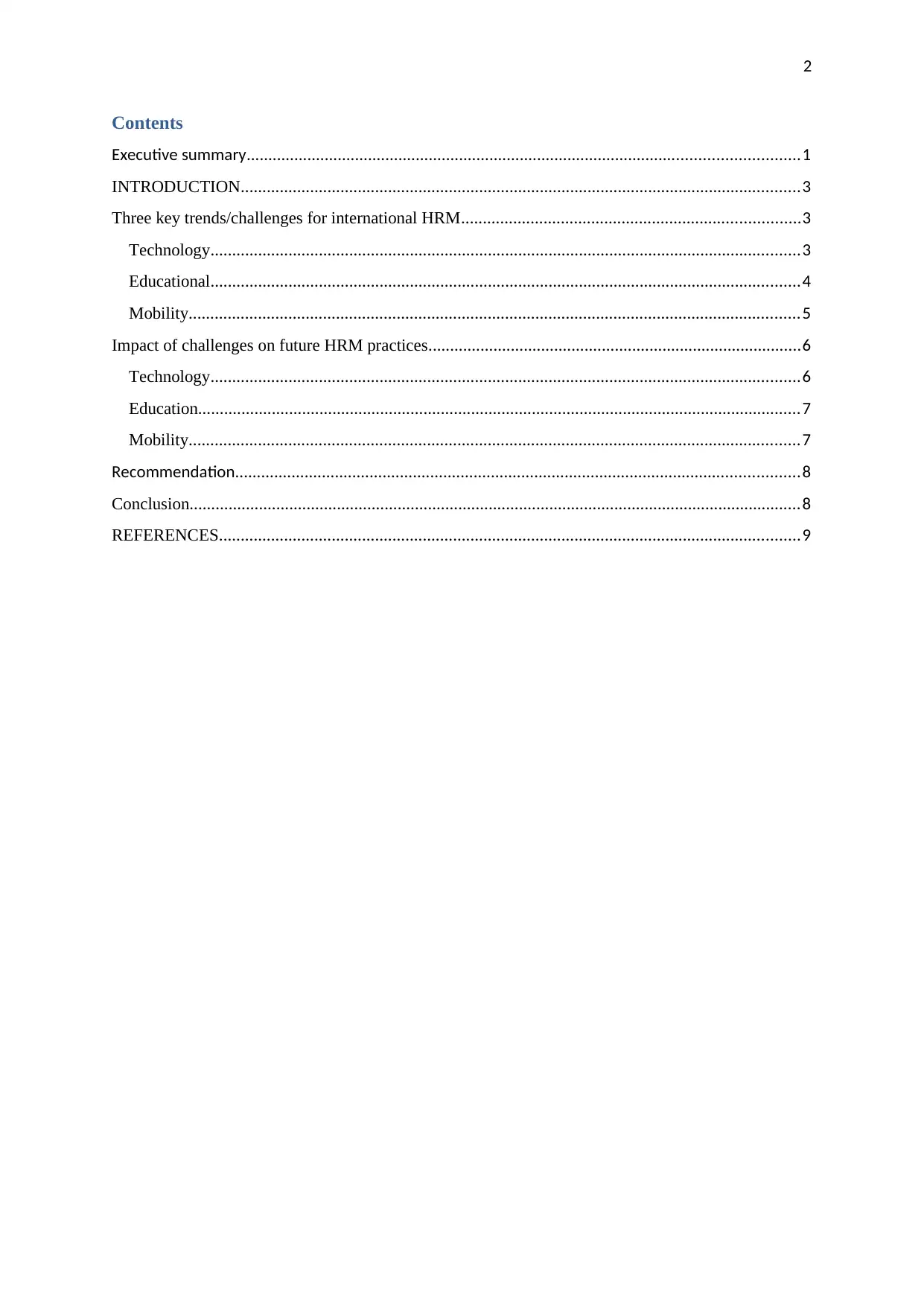
2
Contents
Executive summary...............................................................................................................................1
INTRODUCTION.................................................................................................................................3
Three key trends/challenges for international HRM..............................................................................3
Technology........................................................................................................................................3
Educational........................................................................................................................................4
Mobility.............................................................................................................................................5
Impact of challenges on future HRM practices......................................................................................6
Technology........................................................................................................................................6
Education...........................................................................................................................................7
Mobility.............................................................................................................................................7
Recommendation..................................................................................................................................8
Conclusion.............................................................................................................................................8
REFERENCES......................................................................................................................................9
Contents
Executive summary...............................................................................................................................1
INTRODUCTION.................................................................................................................................3
Three key trends/challenges for international HRM..............................................................................3
Technology........................................................................................................................................3
Educational........................................................................................................................................4
Mobility.............................................................................................................................................5
Impact of challenges on future HRM practices......................................................................................6
Technology........................................................................................................................................6
Education...........................................................................................................................................7
Mobility.............................................................................................................................................7
Recommendation..................................................................................................................................8
Conclusion.............................................................................................................................................8
REFERENCES......................................................................................................................................9
⊘ This is a preview!⊘
Do you want full access?
Subscribe today to unlock all pages.

Trusted by 1+ million students worldwide
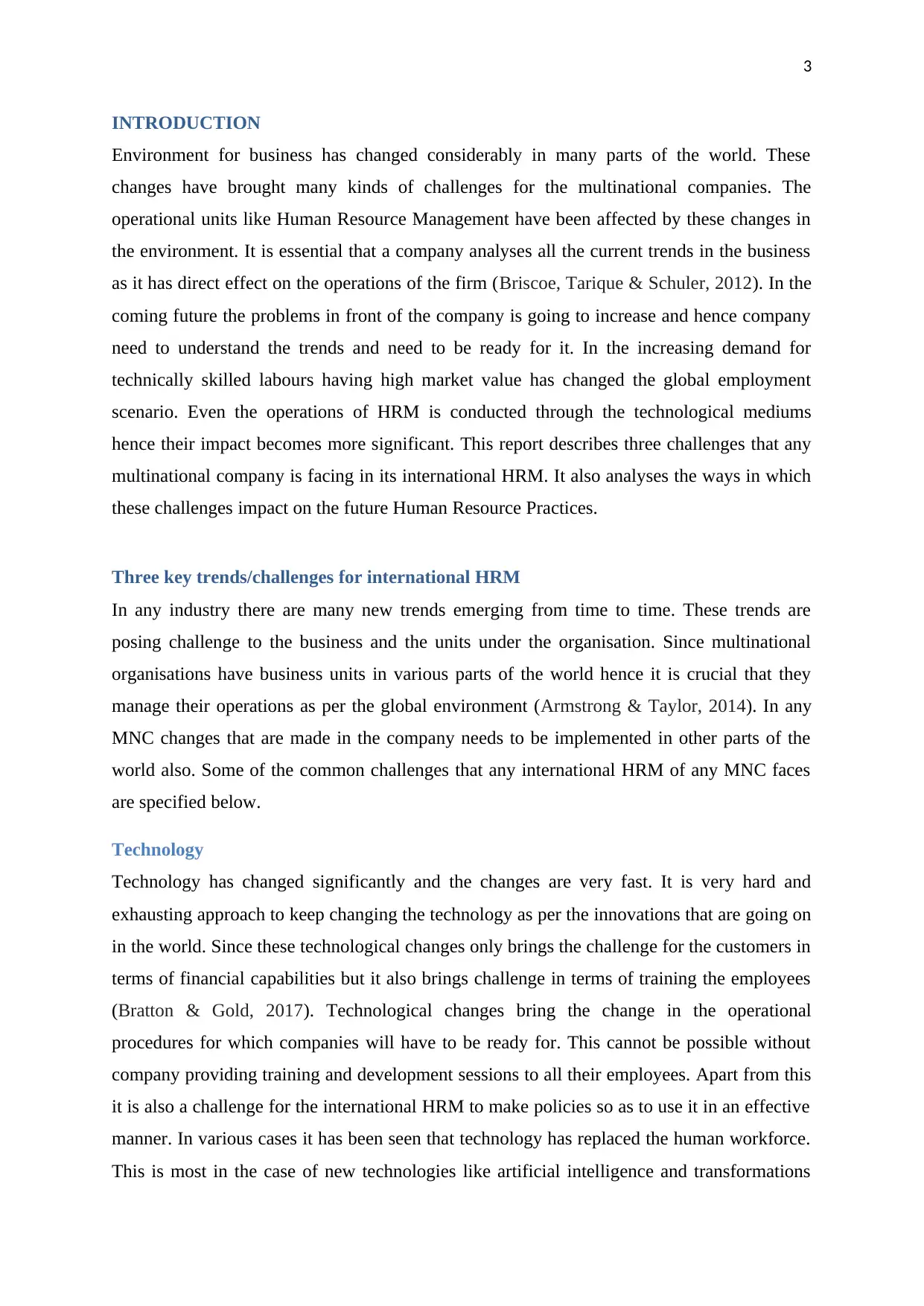
3
INTRODUCTION
Environment for business has changed considerably in many parts of the world. These
changes have brought many kinds of challenges for the multinational companies. The
operational units like Human Resource Management have been affected by these changes in
the environment. It is essential that a company analyses all the current trends in the business
as it has direct effect on the operations of the firm (Briscoe, Tarique & Schuler, 2012). In the
coming future the problems in front of the company is going to increase and hence company
need to understand the trends and need to be ready for it. In the increasing demand for
technically skilled labours having high market value has changed the global employment
scenario. Even the operations of HRM is conducted through the technological mediums
hence their impact becomes more significant. This report describes three challenges that any
multinational company is facing in its international HRM. It also analyses the ways in which
these challenges impact on the future Human Resource Practices.
Three key trends/challenges for international HRM
In any industry there are many new trends emerging from time to time. These trends are
posing challenge to the business and the units under the organisation. Since multinational
organisations have business units in various parts of the world hence it is crucial that they
manage their operations as per the global environment (Armstrong & Taylor, 2014). In any
MNC changes that are made in the company needs to be implemented in other parts of the
world also. Some of the common challenges that any international HRM of any MNC faces
are specified below.
Technology
Technology has changed significantly and the changes are very fast. It is very hard and
exhausting approach to keep changing the technology as per the innovations that are going on
in the world. Since these technological changes only brings the challenge for the customers in
terms of financial capabilities but it also brings challenge in terms of training the employees
(Bratton & Gold, 2017). Technological changes bring the change in the operational
procedures for which companies will have to be ready for. This cannot be possible without
company providing training and development sessions to all their employees. Apart from this
it is also a challenge for the international HRM to make policies so as to use it in an effective
manner. In various cases it has been seen that technology has replaced the human workforce.
This is most in the case of new technologies like artificial intelligence and transformations
INTRODUCTION
Environment for business has changed considerably in many parts of the world. These
changes have brought many kinds of challenges for the multinational companies. The
operational units like Human Resource Management have been affected by these changes in
the environment. It is essential that a company analyses all the current trends in the business
as it has direct effect on the operations of the firm (Briscoe, Tarique & Schuler, 2012). In the
coming future the problems in front of the company is going to increase and hence company
need to understand the trends and need to be ready for it. In the increasing demand for
technically skilled labours having high market value has changed the global employment
scenario. Even the operations of HRM is conducted through the technological mediums
hence their impact becomes more significant. This report describes three challenges that any
multinational company is facing in its international HRM. It also analyses the ways in which
these challenges impact on the future Human Resource Practices.
Three key trends/challenges for international HRM
In any industry there are many new trends emerging from time to time. These trends are
posing challenge to the business and the units under the organisation. Since multinational
organisations have business units in various parts of the world hence it is crucial that they
manage their operations as per the global environment (Armstrong & Taylor, 2014). In any
MNC changes that are made in the company needs to be implemented in other parts of the
world also. Some of the common challenges that any international HRM of any MNC faces
are specified below.
Technology
Technology has changed significantly and the changes are very fast. It is very hard and
exhausting approach to keep changing the technology as per the innovations that are going on
in the world. Since these technological changes only brings the challenge for the customers in
terms of financial capabilities but it also brings challenge in terms of training the employees
(Bratton & Gold, 2017). Technological changes bring the change in the operational
procedures for which companies will have to be ready for. This cannot be possible without
company providing training and development sessions to all their employees. Apart from this
it is also a challenge for the international HRM to make policies so as to use it in an effective
manner. In various cases it has been seen that technology has replaced the human workforce.
This is most in the case of new technologies like artificial intelligence and transformations
Paraphrase This Document
Need a fresh take? Get an instant paraphrase of this document with our AI Paraphraser
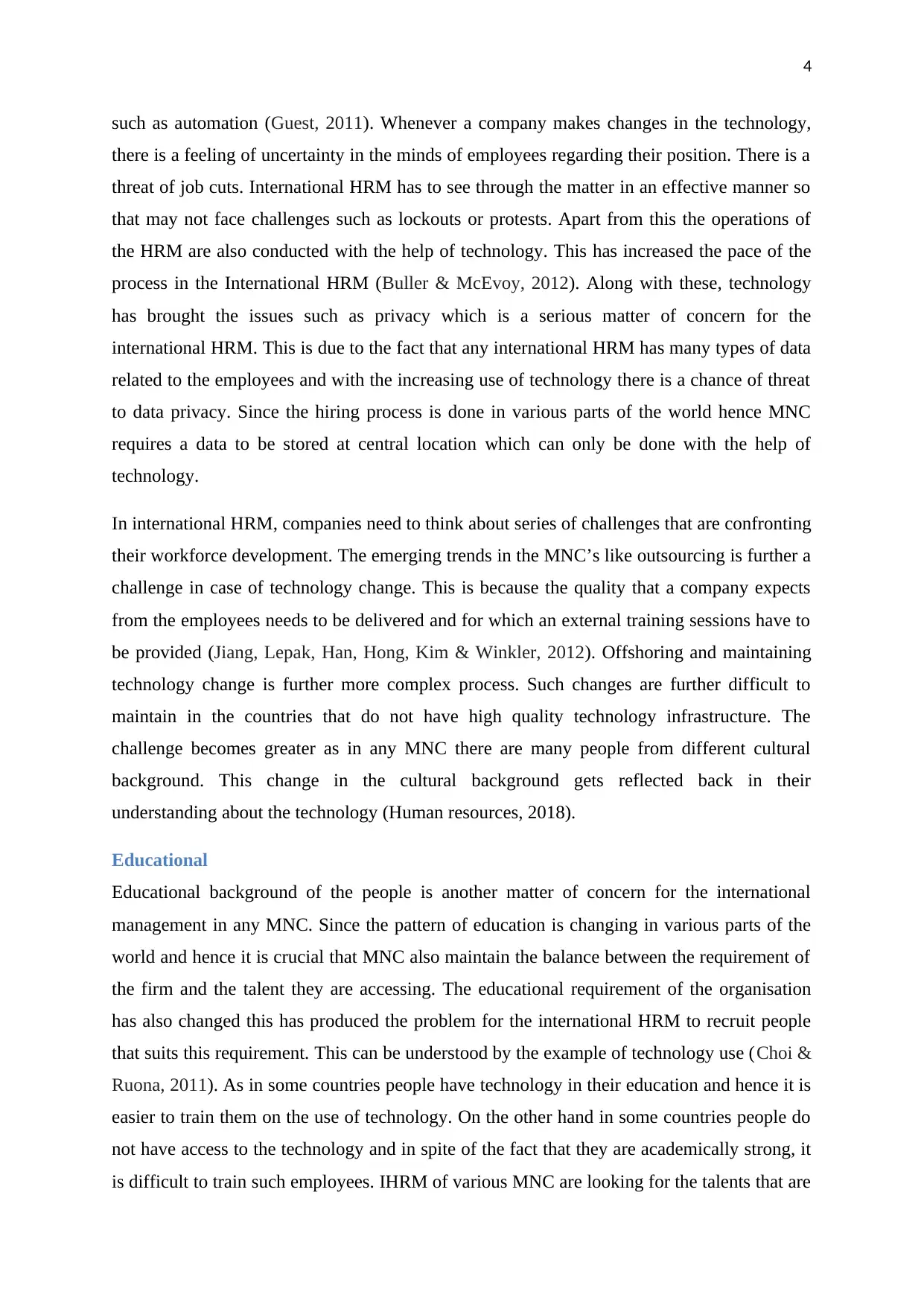
4
such as automation (Guest, 2011). Whenever a company makes changes in the technology,
there is a feeling of uncertainty in the minds of employees regarding their position. There is a
threat of job cuts. International HRM has to see through the matter in an effective manner so
that may not face challenges such as lockouts or protests. Apart from this the operations of
the HRM are also conducted with the help of technology. This has increased the pace of the
process in the International HRM (Buller & McEvoy, 2012). Along with these, technology
has brought the issues such as privacy which is a serious matter of concern for the
international HRM. This is due to the fact that any international HRM has many types of data
related to the employees and with the increasing use of technology there is a chance of threat
to data privacy. Since the hiring process is done in various parts of the world hence MNC
requires a data to be stored at central location which can only be done with the help of
technology.
In international HRM, companies need to think about series of challenges that are confronting
their workforce development. The emerging trends in the MNC’s like outsourcing is further a
challenge in case of technology change. This is because the quality that a company expects
from the employees needs to be delivered and for which an external training sessions have to
be provided (Jiang, Lepak, Han, Hong, Kim & Winkler, 2012). Offshoring and maintaining
technology change is further more complex process. Such changes are further difficult to
maintain in the countries that do not have high quality technology infrastructure. The
challenge becomes greater as in any MNC there are many people from different cultural
background. This change in the cultural background gets reflected back in their
understanding about the technology (Human resources, 2018).
Educational
Educational background of the people is another matter of concern for the international
management in any MNC. Since the pattern of education is changing in various parts of the
world and hence it is crucial that MNC also maintain the balance between the requirement of
the firm and the talent they are accessing. The educational requirement of the organisation
has also changed this has produced the problem for the international HRM to recruit people
that suits this requirement. This can be understood by the example of technology use (Choi &
Ruona, 2011). As in some countries people have technology in their education and hence it is
easier to train them on the use of technology. On the other hand in some countries people do
not have access to the technology and in spite of the fact that they are academically strong, it
is difficult to train such employees. IHRM of various MNC are looking for the talents that are
such as automation (Guest, 2011). Whenever a company makes changes in the technology,
there is a feeling of uncertainty in the minds of employees regarding their position. There is a
threat of job cuts. International HRM has to see through the matter in an effective manner so
that may not face challenges such as lockouts or protests. Apart from this the operations of
the HRM are also conducted with the help of technology. This has increased the pace of the
process in the International HRM (Buller & McEvoy, 2012). Along with these, technology
has brought the issues such as privacy which is a serious matter of concern for the
international HRM. This is due to the fact that any international HRM has many types of data
related to the employees and with the increasing use of technology there is a chance of threat
to data privacy. Since the hiring process is done in various parts of the world hence MNC
requires a data to be stored at central location which can only be done with the help of
technology.
In international HRM, companies need to think about series of challenges that are confronting
their workforce development. The emerging trends in the MNC’s like outsourcing is further a
challenge in case of technology change. This is because the quality that a company expects
from the employees needs to be delivered and for which an external training sessions have to
be provided (Jiang, Lepak, Han, Hong, Kim & Winkler, 2012). Offshoring and maintaining
technology change is further more complex process. Such changes are further difficult to
maintain in the countries that do not have high quality technology infrastructure. The
challenge becomes greater as in any MNC there are many people from different cultural
background. This change in the cultural background gets reflected back in their
understanding about the technology (Human resources, 2018).
Educational
Educational background of the people is another matter of concern for the international
management in any MNC. Since the pattern of education is changing in various parts of the
world and hence it is crucial that MNC also maintain the balance between the requirement of
the firm and the talent they are accessing. The educational requirement of the organisation
has also changed this has produced the problem for the international HRM to recruit people
that suits this requirement. This can be understood by the example of technology use (Choi &
Ruona, 2011). As in some countries people have technology in their education and hence it is
easier to train them on the use of technology. On the other hand in some countries people do
not have access to the technology and in spite of the fact that they are academically strong, it
is difficult to train such employees. IHRM of various MNC are looking for the talents that are
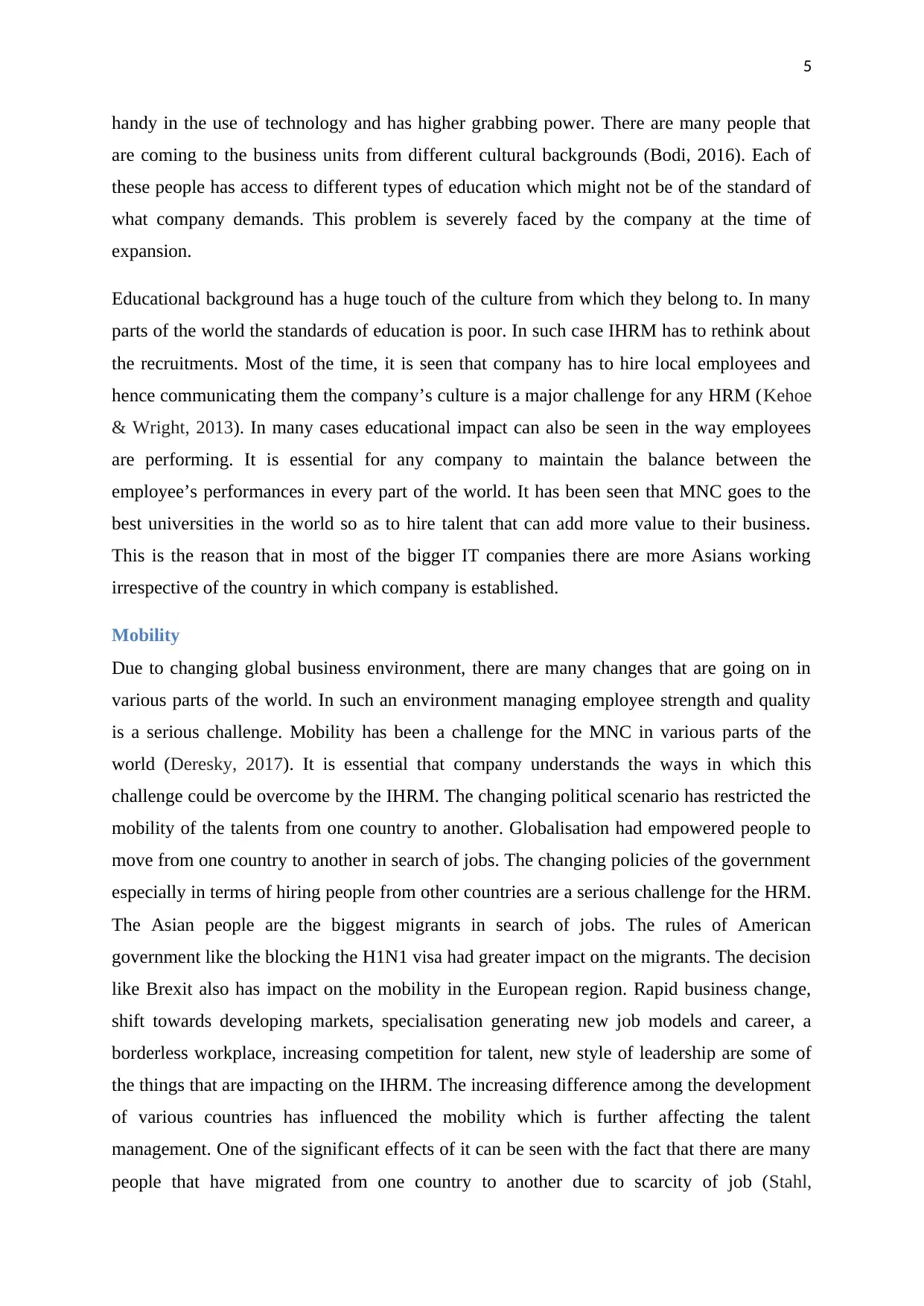
5
handy in the use of technology and has higher grabbing power. There are many people that
are coming to the business units from different cultural backgrounds (Bodi, 2016). Each of
these people has access to different types of education which might not be of the standard of
what company demands. This problem is severely faced by the company at the time of
expansion.
Educational background has a huge touch of the culture from which they belong to. In many
parts of the world the standards of education is poor. In such case IHRM has to rethink about
the recruitments. Most of the time, it is seen that company has to hire local employees and
hence communicating them the company’s culture is a major challenge for any HRM (Kehoe
& Wright, 2013). In many cases educational impact can also be seen in the way employees
are performing. It is essential for any company to maintain the balance between the
employee’s performances in every part of the world. It has been seen that MNC goes to the
best universities in the world so as to hire talent that can add more value to their business.
This is the reason that in most of the bigger IT companies there are more Asians working
irrespective of the country in which company is established.
Mobility
Due to changing global business environment, there are many changes that are going on in
various parts of the world. In such an environment managing employee strength and quality
is a serious challenge. Mobility has been a challenge for the MNC in various parts of the
world (Deresky, 2017). It is essential that company understands the ways in which this
challenge could be overcome by the IHRM. The changing political scenario has restricted the
mobility of the talents from one country to another. Globalisation had empowered people to
move from one country to another in search of jobs. The changing policies of the government
especially in terms of hiring people from other countries are a serious challenge for the HRM.
The Asian people are the biggest migrants in search of jobs. The rules of American
government like the blocking the H1N1 visa had greater impact on the migrants. The decision
like Brexit also has impact on the mobility in the European region. Rapid business change,
shift towards developing markets, specialisation generating new job models and career, a
borderless workplace, increasing competition for talent, new style of leadership are some of
the things that are impacting on the IHRM. The increasing difference among the development
of various countries has influenced the mobility which is further affecting the talent
management. One of the significant effects of it can be seen with the fact that there are many
people that have migrated from one country to another due to scarcity of job (Stahl,
handy in the use of technology and has higher grabbing power. There are many people that
are coming to the business units from different cultural backgrounds (Bodi, 2016). Each of
these people has access to different types of education which might not be of the standard of
what company demands. This problem is severely faced by the company at the time of
expansion.
Educational background has a huge touch of the culture from which they belong to. In many
parts of the world the standards of education is poor. In such case IHRM has to rethink about
the recruitments. Most of the time, it is seen that company has to hire local employees and
hence communicating them the company’s culture is a major challenge for any HRM (Kehoe
& Wright, 2013). In many cases educational impact can also be seen in the way employees
are performing. It is essential for any company to maintain the balance between the
employee’s performances in every part of the world. It has been seen that MNC goes to the
best universities in the world so as to hire talent that can add more value to their business.
This is the reason that in most of the bigger IT companies there are more Asians working
irrespective of the country in which company is established.
Mobility
Due to changing global business environment, there are many changes that are going on in
various parts of the world. In such an environment managing employee strength and quality
is a serious challenge. Mobility has been a challenge for the MNC in various parts of the
world (Deresky, 2017). It is essential that company understands the ways in which this
challenge could be overcome by the IHRM. The changing political scenario has restricted the
mobility of the talents from one country to another. Globalisation had empowered people to
move from one country to another in search of jobs. The changing policies of the government
especially in terms of hiring people from other countries are a serious challenge for the HRM.
The Asian people are the biggest migrants in search of jobs. The rules of American
government like the blocking the H1N1 visa had greater impact on the migrants. The decision
like Brexit also has impact on the mobility in the European region. Rapid business change,
shift towards developing markets, specialisation generating new job models and career, a
borderless workplace, increasing competition for talent, new style of leadership are some of
the things that are impacting on the IHRM. The increasing difference among the development
of various countries has influenced the mobility which is further affecting the talent
management. One of the significant effects of it can be seen with the fact that there are many
people that have migrated from one country to another due to scarcity of job (Stahl,
⊘ This is a preview!⊘
Do you want full access?
Subscribe today to unlock all pages.

Trusted by 1+ million students worldwide
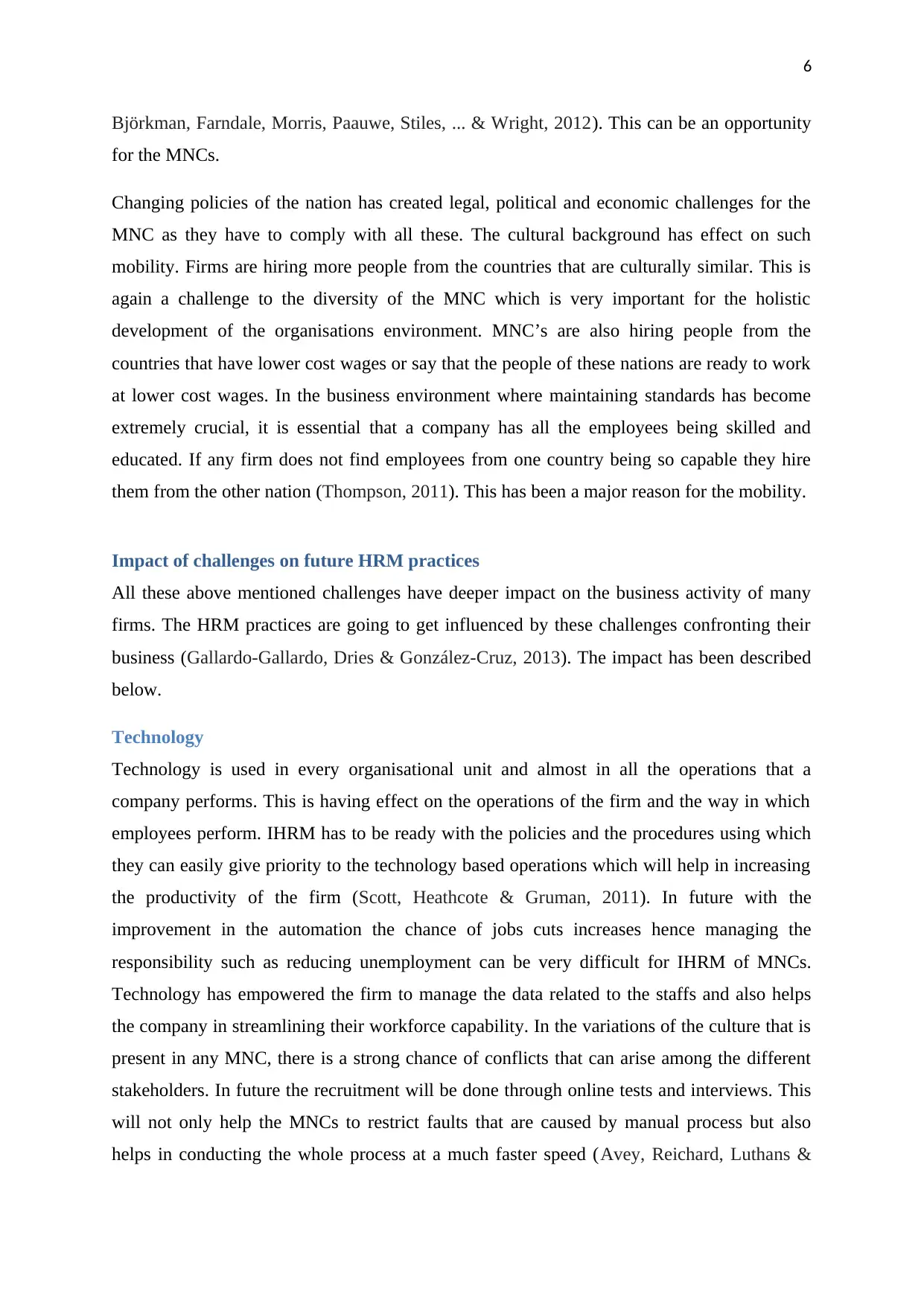
6
Björkman, Farndale, Morris, Paauwe, Stiles, ... & Wright, 2012). This can be an opportunity
for the MNCs.
Changing policies of the nation has created legal, political and economic challenges for the
MNC as they have to comply with all these. The cultural background has effect on such
mobility. Firms are hiring more people from the countries that are culturally similar. This is
again a challenge to the diversity of the MNC which is very important for the holistic
development of the organisations environment. MNC’s are also hiring people from the
countries that have lower cost wages or say that the people of these nations are ready to work
at lower cost wages. In the business environment where maintaining standards has become
extremely crucial, it is essential that a company has all the employees being skilled and
educated. If any firm does not find employees from one country being so capable they hire
them from the other nation (Thompson, 2011). This has been a major reason for the mobility.
Impact of challenges on future HRM practices
All these above mentioned challenges have deeper impact on the business activity of many
firms. The HRM practices are going to get influenced by these challenges confronting their
business (Gallardo-Gallardo, Dries & González-Cruz, 2013). The impact has been described
below.
Technology
Technology is used in every organisational unit and almost in all the operations that a
company performs. This is having effect on the operations of the firm and the way in which
employees perform. IHRM has to be ready with the policies and the procedures using which
they can easily give priority to the technology based operations which will help in increasing
the productivity of the firm (Scott, Heathcote & Gruman, 2011). In future with the
improvement in the automation the chance of jobs cuts increases hence managing the
responsibility such as reducing unemployment can be very difficult for IHRM of MNCs.
Technology has empowered the firm to manage the data related to the staffs and also helps
the company in streamlining their workforce capability. In the variations of the culture that is
present in any MNC, there is a strong chance of conflicts that can arise among the different
stakeholders. In future the recruitment will be done through online tests and interviews. This
will not only help the MNCs to restrict faults that are caused by manual process but also
helps in conducting the whole process at a much faster speed (Avey, Reichard, Luthans &
Björkman, Farndale, Morris, Paauwe, Stiles, ... & Wright, 2012). This can be an opportunity
for the MNCs.
Changing policies of the nation has created legal, political and economic challenges for the
MNC as they have to comply with all these. The cultural background has effect on such
mobility. Firms are hiring more people from the countries that are culturally similar. This is
again a challenge to the diversity of the MNC which is very important for the holistic
development of the organisations environment. MNC’s are also hiring people from the
countries that have lower cost wages or say that the people of these nations are ready to work
at lower cost wages. In the business environment where maintaining standards has become
extremely crucial, it is essential that a company has all the employees being skilled and
educated. If any firm does not find employees from one country being so capable they hire
them from the other nation (Thompson, 2011). This has been a major reason for the mobility.
Impact of challenges on future HRM practices
All these above mentioned challenges have deeper impact on the business activity of many
firms. The HRM practices are going to get influenced by these challenges confronting their
business (Gallardo-Gallardo, Dries & González-Cruz, 2013). The impact has been described
below.
Technology
Technology is used in every organisational unit and almost in all the operations that a
company performs. This is having effect on the operations of the firm and the way in which
employees perform. IHRM has to be ready with the policies and the procedures using which
they can easily give priority to the technology based operations which will help in increasing
the productivity of the firm (Scott, Heathcote & Gruman, 2011). In future with the
improvement in the automation the chance of jobs cuts increases hence managing the
responsibility such as reducing unemployment can be very difficult for IHRM of MNCs.
Technology has empowered the firm to manage the data related to the staffs and also helps
the company in streamlining their workforce capability. In the variations of the culture that is
present in any MNC, there is a strong chance of conflicts that can arise among the different
stakeholders. In future the recruitment will be done through online tests and interviews. This
will not only help the MNCs to restrict faults that are caused by manual process but also
helps in conducting the whole process at a much faster speed (Avey, Reichard, Luthans &
Paraphrase This Document
Need a fresh take? Get an instant paraphrase of this document with our AI Paraphraser
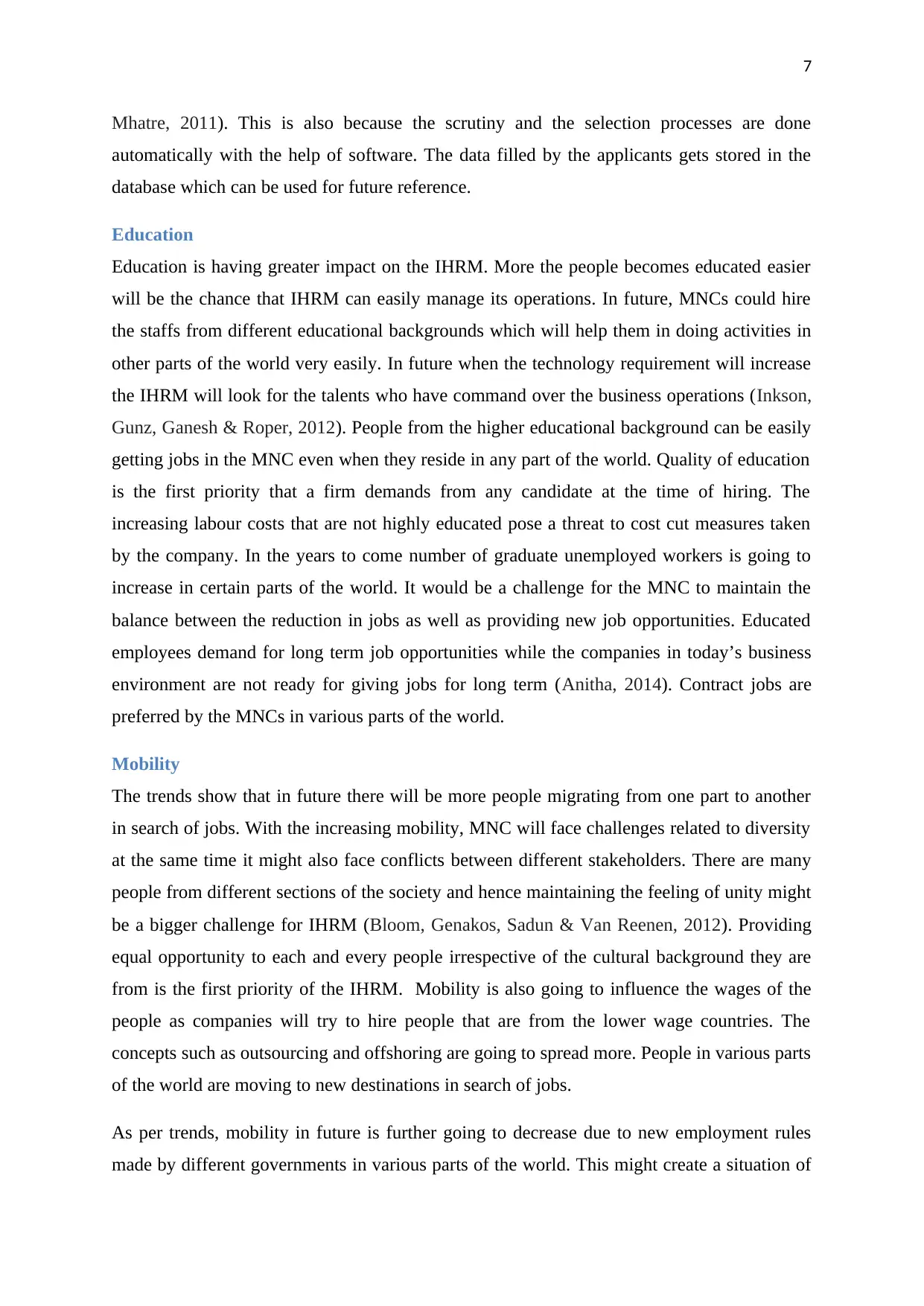
7
Mhatre, 2011). This is also because the scrutiny and the selection processes are done
automatically with the help of software. The data filled by the applicants gets stored in the
database which can be used for future reference.
Education
Education is having greater impact on the IHRM. More the people becomes educated easier
will be the chance that IHRM can easily manage its operations. In future, MNCs could hire
the staffs from different educational backgrounds which will help them in doing activities in
other parts of the world very easily. In future when the technology requirement will increase
the IHRM will look for the talents who have command over the business operations (Inkson,
Gunz, Ganesh & Roper, 2012). People from the higher educational background can be easily
getting jobs in the MNC even when they reside in any part of the world. Quality of education
is the first priority that a firm demands from any candidate at the time of hiring. The
increasing labour costs that are not highly educated pose a threat to cost cut measures taken
by the company. In the years to come number of graduate unemployed workers is going to
increase in certain parts of the world. It would be a challenge for the MNC to maintain the
balance between the reduction in jobs as well as providing new job opportunities. Educated
employees demand for long term job opportunities while the companies in today’s business
environment are not ready for giving jobs for long term (Anitha, 2014). Contract jobs are
preferred by the MNCs in various parts of the world.
Mobility
The trends show that in future there will be more people migrating from one part to another
in search of jobs. With the increasing mobility, MNC will face challenges related to diversity
at the same time it might also face conflicts between different stakeholders. There are many
people from different sections of the society and hence maintaining the feeling of unity might
be a bigger challenge for IHRM (Bloom, Genakos, Sadun & Van Reenen, 2012). Providing
equal opportunity to each and every people irrespective of the cultural background they are
from is the first priority of the IHRM. Mobility is also going to influence the wages of the
people as companies will try to hire people that are from the lower wage countries. The
concepts such as outsourcing and offshoring are going to spread more. People in various parts
of the world are moving to new destinations in search of jobs.
As per trends, mobility in future is further going to decrease due to new employment rules
made by different governments in various parts of the world. This might create a situation of
Mhatre, 2011). This is also because the scrutiny and the selection processes are done
automatically with the help of software. The data filled by the applicants gets stored in the
database which can be used for future reference.
Education
Education is having greater impact on the IHRM. More the people becomes educated easier
will be the chance that IHRM can easily manage its operations. In future, MNCs could hire
the staffs from different educational backgrounds which will help them in doing activities in
other parts of the world very easily. In future when the technology requirement will increase
the IHRM will look for the talents who have command over the business operations (Inkson,
Gunz, Ganesh & Roper, 2012). People from the higher educational background can be easily
getting jobs in the MNC even when they reside in any part of the world. Quality of education
is the first priority that a firm demands from any candidate at the time of hiring. The
increasing labour costs that are not highly educated pose a threat to cost cut measures taken
by the company. In the years to come number of graduate unemployed workers is going to
increase in certain parts of the world. It would be a challenge for the MNC to maintain the
balance between the reduction in jobs as well as providing new job opportunities. Educated
employees demand for long term job opportunities while the companies in today’s business
environment are not ready for giving jobs for long term (Anitha, 2014). Contract jobs are
preferred by the MNCs in various parts of the world.
Mobility
The trends show that in future there will be more people migrating from one part to another
in search of jobs. With the increasing mobility, MNC will face challenges related to diversity
at the same time it might also face conflicts between different stakeholders. There are many
people from different sections of the society and hence maintaining the feeling of unity might
be a bigger challenge for IHRM (Bloom, Genakos, Sadun & Van Reenen, 2012). Providing
equal opportunity to each and every people irrespective of the cultural background they are
from is the first priority of the IHRM. Mobility is also going to influence the wages of the
people as companies will try to hire people that are from the lower wage countries. The
concepts such as outsourcing and offshoring are going to spread more. People in various parts
of the world are moving to new destinations in search of jobs.
As per trends, mobility in future is further going to decrease due to new employment rules
made by different governments in various parts of the world. This might create a situation of
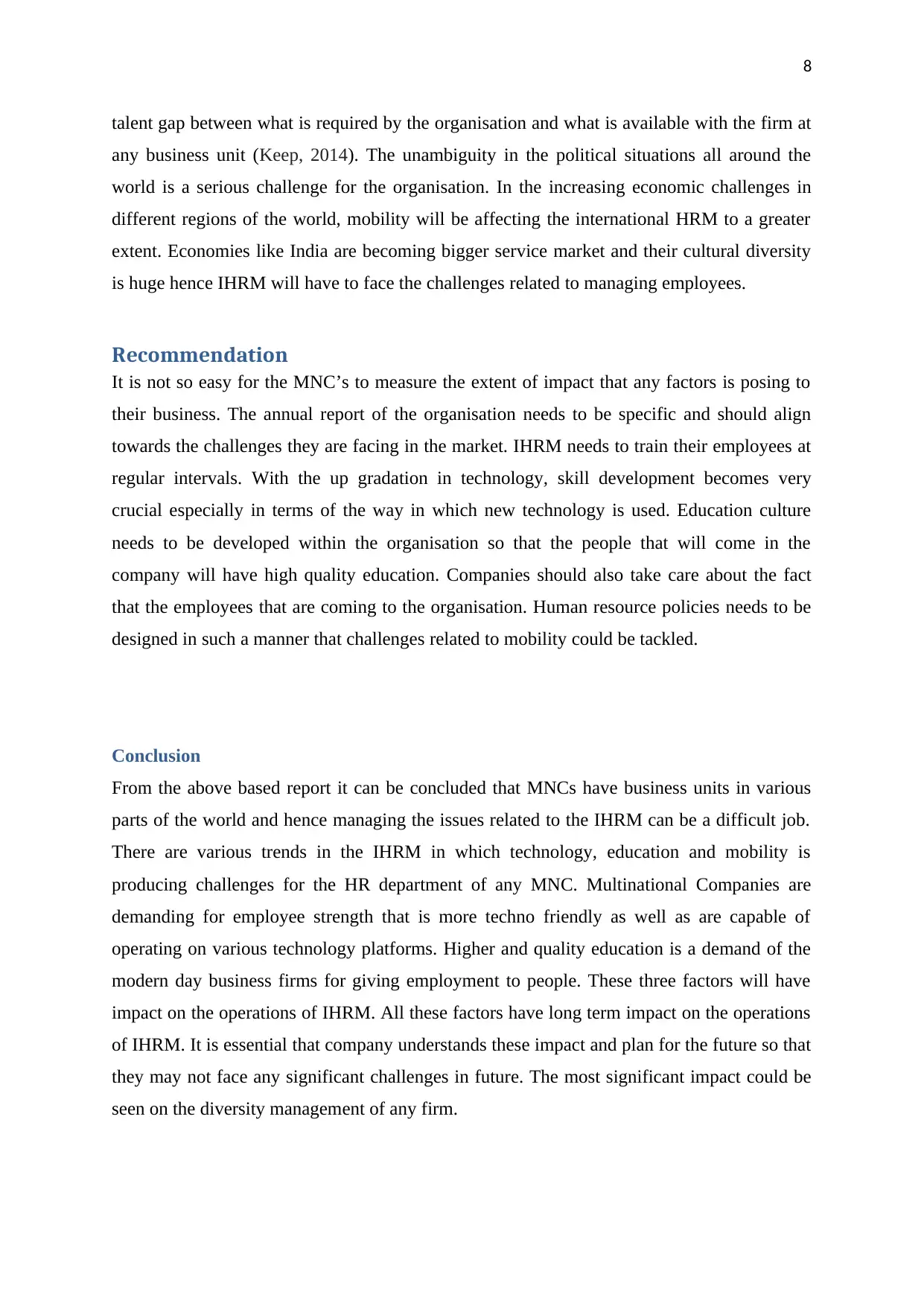
8
talent gap between what is required by the organisation and what is available with the firm at
any business unit (Keep, 2014). The unambiguity in the political situations all around the
world is a serious challenge for the organisation. In the increasing economic challenges in
different regions of the world, mobility will be affecting the international HRM to a greater
extent. Economies like India are becoming bigger service market and their cultural diversity
is huge hence IHRM will have to face the challenges related to managing employees.
Recommendation
It is not so easy for the MNC’s to measure the extent of impact that any factors is posing to
their business. The annual report of the organisation needs to be specific and should align
towards the challenges they are facing in the market. IHRM needs to train their employees at
regular intervals. With the up gradation in technology, skill development becomes very
crucial especially in terms of the way in which new technology is used. Education culture
needs to be developed within the organisation so that the people that will come in the
company will have high quality education. Companies should also take care about the fact
that the employees that are coming to the organisation. Human resource policies needs to be
designed in such a manner that challenges related to mobility could be tackled.
Conclusion
From the above based report it can be concluded that MNCs have business units in various
parts of the world and hence managing the issues related to the IHRM can be a difficult job.
There are various trends in the IHRM in which technology, education and mobility is
producing challenges for the HR department of any MNC. Multinational Companies are
demanding for employee strength that is more techno friendly as well as are capable of
operating on various technology platforms. Higher and quality education is a demand of the
modern day business firms for giving employment to people. These three factors will have
impact on the operations of IHRM. All these factors have long term impact on the operations
of IHRM. It is essential that company understands these impact and plan for the future so that
they may not face any significant challenges in future. The most significant impact could be
seen on the diversity management of any firm.
talent gap between what is required by the organisation and what is available with the firm at
any business unit (Keep, 2014). The unambiguity in the political situations all around the
world is a serious challenge for the organisation. In the increasing economic challenges in
different regions of the world, mobility will be affecting the international HRM to a greater
extent. Economies like India are becoming bigger service market and their cultural diversity
is huge hence IHRM will have to face the challenges related to managing employees.
Recommendation
It is not so easy for the MNC’s to measure the extent of impact that any factors is posing to
their business. The annual report of the organisation needs to be specific and should align
towards the challenges they are facing in the market. IHRM needs to train their employees at
regular intervals. With the up gradation in technology, skill development becomes very
crucial especially in terms of the way in which new technology is used. Education culture
needs to be developed within the organisation so that the people that will come in the
company will have high quality education. Companies should also take care about the fact
that the employees that are coming to the organisation. Human resource policies needs to be
designed in such a manner that challenges related to mobility could be tackled.
Conclusion
From the above based report it can be concluded that MNCs have business units in various
parts of the world and hence managing the issues related to the IHRM can be a difficult job.
There are various trends in the IHRM in which technology, education and mobility is
producing challenges for the HR department of any MNC. Multinational Companies are
demanding for employee strength that is more techno friendly as well as are capable of
operating on various technology platforms. Higher and quality education is a demand of the
modern day business firms for giving employment to people. These three factors will have
impact on the operations of IHRM. All these factors have long term impact on the operations
of IHRM. It is essential that company understands these impact and plan for the future so that
they may not face any significant challenges in future. The most significant impact could be
seen on the diversity management of any firm.
⊘ This is a preview!⊘
Do you want full access?
Subscribe today to unlock all pages.

Trusted by 1+ million students worldwide
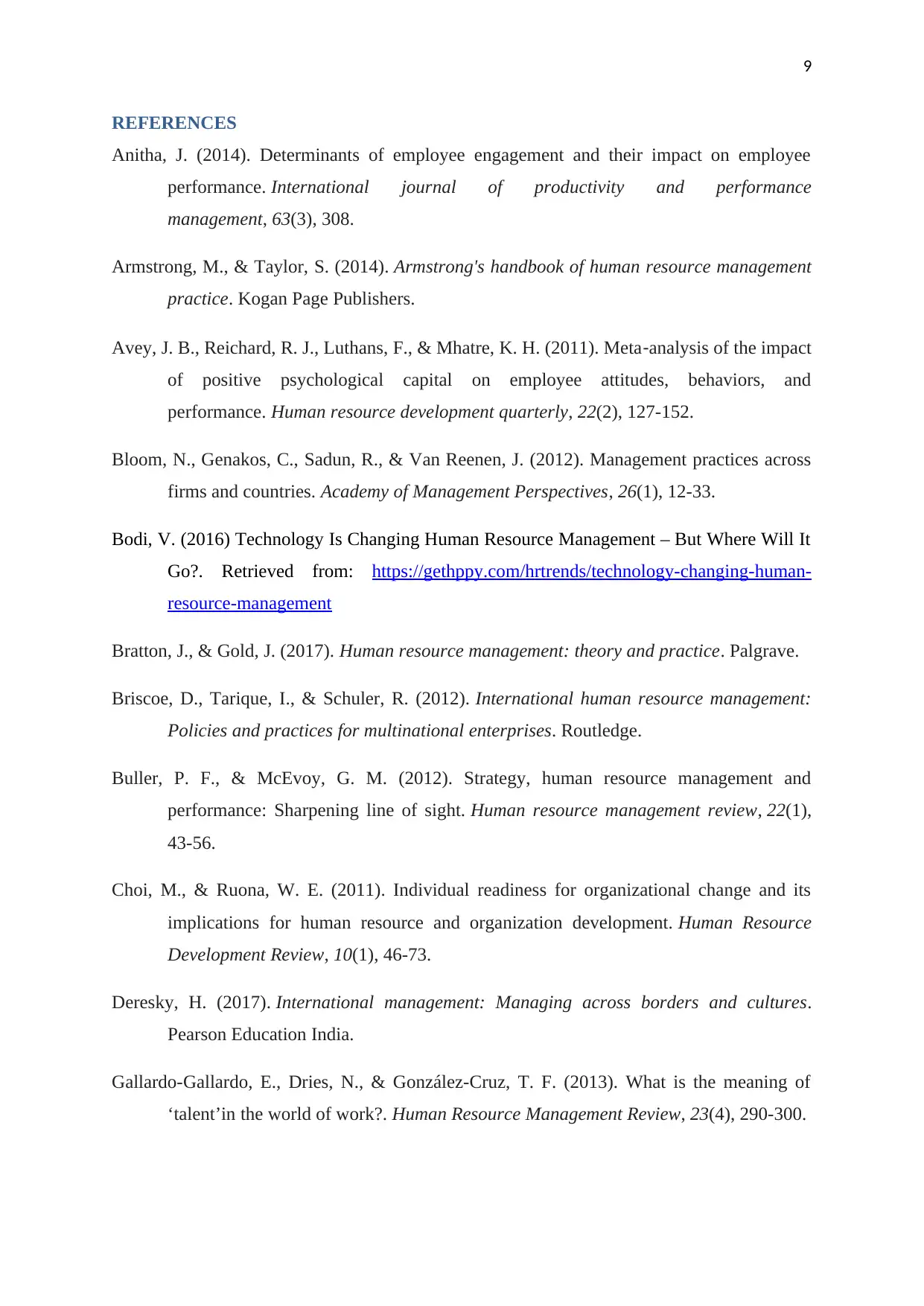
9
REFERENCES
Anitha, J. (2014). Determinants of employee engagement and their impact on employee
performance. International journal of productivity and performance
management, 63(3), 308.
Armstrong, M., & Taylor, S. (2014). Armstrong's handbook of human resource management
practice. Kogan Page Publishers.
Avey, J. B., Reichard, R. J., Luthans, F., & Mhatre, K. H. (2011). Meta‐analysis of the impact
of positive psychological capital on employee attitudes, behaviors, and
performance. Human resource development quarterly, 22(2), 127-152.
Bloom, N., Genakos, C., Sadun, R., & Van Reenen, J. (2012). Management practices across
firms and countries. Academy of Management Perspectives, 26(1), 12-33.
Bodi, V. (2016) Technology Is Changing Human Resource Management – But Where Will It
Go?. Retrieved from: https://gethppy.com/hrtrends/technology-changing-human-
resource-management
Bratton, J., & Gold, J. (2017). Human resource management: theory and practice. Palgrave.
Briscoe, D., Tarique, I., & Schuler, R. (2012). International human resource management:
Policies and practices for multinational enterprises. Routledge.
Buller, P. F., & McEvoy, G. M. (2012). Strategy, human resource management and
performance: Sharpening line of sight. Human resource management review, 22(1),
43-56.
Choi, M., & Ruona, W. E. (2011). Individual readiness for organizational change and its
implications for human resource and organization development. Human Resource
Development Review, 10(1), 46-73.
Deresky, H. (2017). International management: Managing across borders and cultures.
Pearson Education India.
Gallardo-Gallardo, E., Dries, N., & González-Cruz, T. F. (2013). What is the meaning of
‘talent’in the world of work?. Human Resource Management Review, 23(4), 290-300.
REFERENCES
Anitha, J. (2014). Determinants of employee engagement and their impact on employee
performance. International journal of productivity and performance
management, 63(3), 308.
Armstrong, M., & Taylor, S. (2014). Armstrong's handbook of human resource management
practice. Kogan Page Publishers.
Avey, J. B., Reichard, R. J., Luthans, F., & Mhatre, K. H. (2011). Meta‐analysis of the impact
of positive psychological capital on employee attitudes, behaviors, and
performance. Human resource development quarterly, 22(2), 127-152.
Bloom, N., Genakos, C., Sadun, R., & Van Reenen, J. (2012). Management practices across
firms and countries. Academy of Management Perspectives, 26(1), 12-33.
Bodi, V. (2016) Technology Is Changing Human Resource Management – But Where Will It
Go?. Retrieved from: https://gethppy.com/hrtrends/technology-changing-human-
resource-management
Bratton, J., & Gold, J. (2017). Human resource management: theory and practice. Palgrave.
Briscoe, D., Tarique, I., & Schuler, R. (2012). International human resource management:
Policies and practices for multinational enterprises. Routledge.
Buller, P. F., & McEvoy, G. M. (2012). Strategy, human resource management and
performance: Sharpening line of sight. Human resource management review, 22(1),
43-56.
Choi, M., & Ruona, W. E. (2011). Individual readiness for organizational change and its
implications for human resource and organization development. Human Resource
Development Review, 10(1), 46-73.
Deresky, H. (2017). International management: Managing across borders and cultures.
Pearson Education India.
Gallardo-Gallardo, E., Dries, N., & González-Cruz, T. F. (2013). What is the meaning of
‘talent’in the world of work?. Human Resource Management Review, 23(4), 290-300.
Paraphrase This Document
Need a fresh take? Get an instant paraphrase of this document with our AI Paraphraser
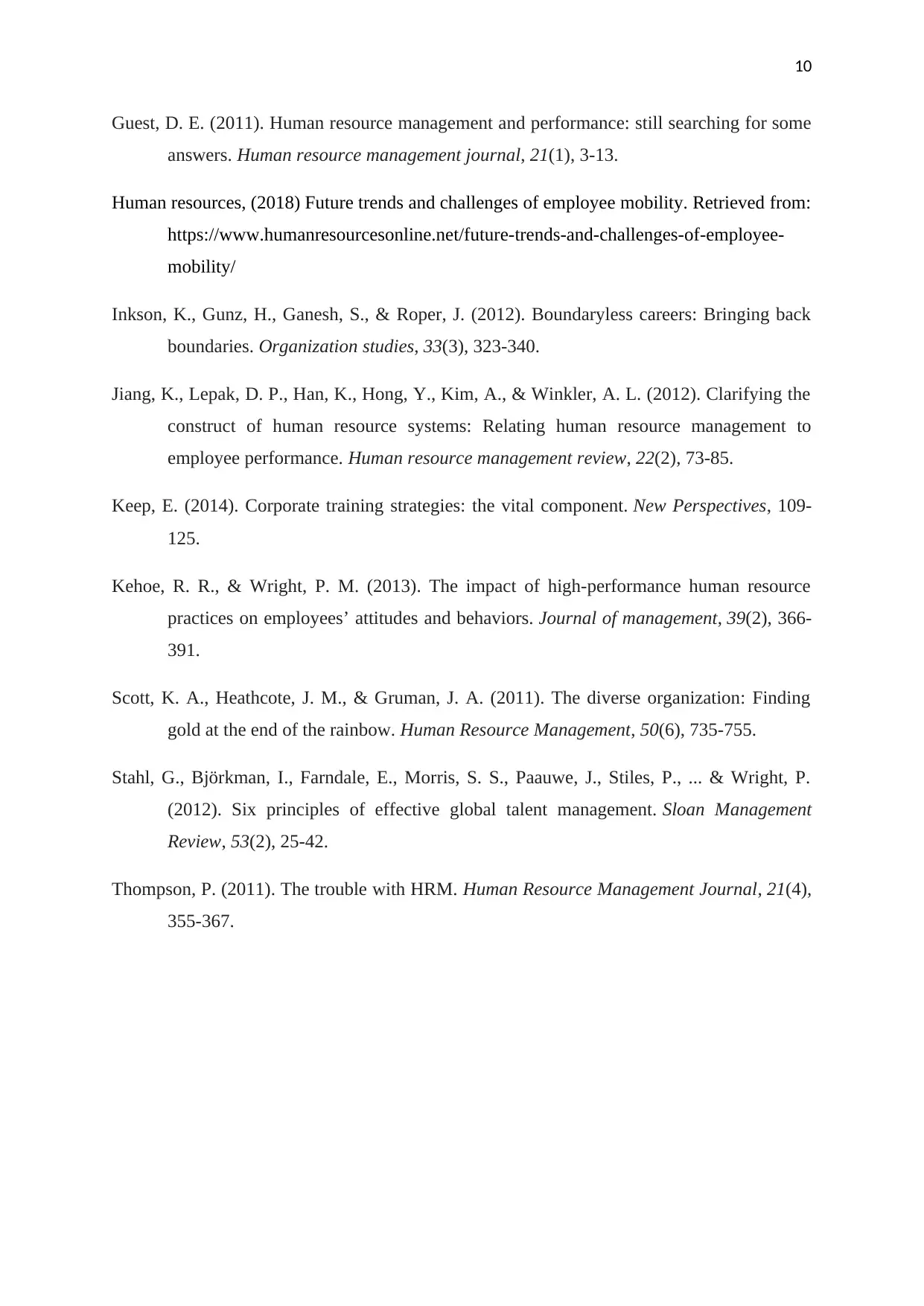
10
Guest, D. E. (2011). Human resource management and performance: still searching for some
answers. Human resource management journal, 21(1), 3-13.
Human resources, (2018) Future trends and challenges of employee mobility. Retrieved from:
https://www.humanresourcesonline.net/future-trends-and-challenges-of-employee-
mobility/
Inkson, K., Gunz, H., Ganesh, S., & Roper, J. (2012). Boundaryless careers: Bringing back
boundaries. Organization studies, 33(3), 323-340.
Jiang, K., Lepak, D. P., Han, K., Hong, Y., Kim, A., & Winkler, A. L. (2012). Clarifying the
construct of human resource systems: Relating human resource management to
employee performance. Human resource management review, 22(2), 73-85.
Keep, E. (2014). Corporate training strategies: the vital component. New Perspectives, 109-
125.
Kehoe, R. R., & Wright, P. M. (2013). The impact of high-performance human resource
practices on employees’ attitudes and behaviors. Journal of management, 39(2), 366-
391.
Scott, K. A., Heathcote, J. M., & Gruman, J. A. (2011). The diverse organization: Finding
gold at the end of the rainbow. Human Resource Management, 50(6), 735-755.
Stahl, G., Björkman, I., Farndale, E., Morris, S. S., Paauwe, J., Stiles, P., ... & Wright, P.
(2012). Six principles of effective global talent management. Sloan Management
Review, 53(2), 25-42.
Thompson, P. (2011). The trouble with HRM. Human Resource Management Journal, 21(4),
355-367.
Guest, D. E. (2011). Human resource management and performance: still searching for some
answers. Human resource management journal, 21(1), 3-13.
Human resources, (2018) Future trends and challenges of employee mobility. Retrieved from:
https://www.humanresourcesonline.net/future-trends-and-challenges-of-employee-
mobility/
Inkson, K., Gunz, H., Ganesh, S., & Roper, J. (2012). Boundaryless careers: Bringing back
boundaries. Organization studies, 33(3), 323-340.
Jiang, K., Lepak, D. P., Han, K., Hong, Y., Kim, A., & Winkler, A. L. (2012). Clarifying the
construct of human resource systems: Relating human resource management to
employee performance. Human resource management review, 22(2), 73-85.
Keep, E. (2014). Corporate training strategies: the vital component. New Perspectives, 109-
125.
Kehoe, R. R., & Wright, P. M. (2013). The impact of high-performance human resource
practices on employees’ attitudes and behaviors. Journal of management, 39(2), 366-
391.
Scott, K. A., Heathcote, J. M., & Gruman, J. A. (2011). The diverse organization: Finding
gold at the end of the rainbow. Human Resource Management, 50(6), 735-755.
Stahl, G., Björkman, I., Farndale, E., Morris, S. S., Paauwe, J., Stiles, P., ... & Wright, P.
(2012). Six principles of effective global talent management. Sloan Management
Review, 53(2), 25-42.
Thompson, P. (2011). The trouble with HRM. Human Resource Management Journal, 21(4),
355-367.
1 out of 11
Related Documents
Your All-in-One AI-Powered Toolkit for Academic Success.
+13062052269
info@desklib.com
Available 24*7 on WhatsApp / Email
![[object Object]](/_next/static/media/star-bottom.7253800d.svg)
Unlock your academic potential
Copyright © 2020–2025 A2Z Services. All Rights Reserved. Developed and managed by ZUCOL.





